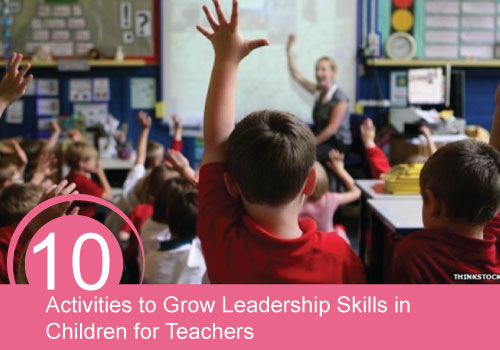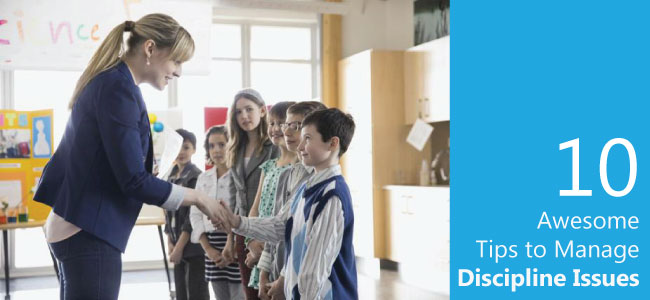Leadership is not about titles, positions or flowcharts. It is about one life influencing another. John C. Maxwell
While some kids are good leaders by nature, other students need to be encouraged, role modeled, and nurtured to develop leadership skills. By being a leader, a child will develop qualities such as honesty, belief in one, dedication towards the task, being a good listener and positive attitude. Teachers, caregivers, parents and other family members can encourage the development of these qualities in early life.
Building Leadership in Kids – Teacher’s Role
Let us consider a school environment. Teachers can give children opportunities to serve in leadership roles. They can teach the skills necessary for children to take on leadership roles now and in the future
- 1. Leadership activities can help kids to-
- 2. Check the positive as well as negative aspects of their behavior
- 3. Identify areas where they lack courage and improve
- 4. Boost self-confidence
- 5. Express themselves to others correctly
- 6. Develop organizational skills
Certain ways to develop leadership skills in children include helping them learn to see different viewpoints in a situation which will help to manage multiple opinions in a group setting, teaching them to set goals and try to do their best at everything, helping them maintain a positive attitude even when others make things difficult or tell them they can’t achieve something and teaching them that mistakes will always happen and are a natural part of life and not to let the mistakes beat them down.
Activities That Teachers Can Adopt
Get FREE Teacher Apps (Check it Now)
1. “Create a New You” – The game requires materials such as a crayons, poster board/construction paper, magazines, scissors, and newspapers. Ask children to sketch themselves on the board or paper. Tell them to make identifications to clearly show that the picture is theirs.
They can use magazine or newspaper cut outs which include their favorite activities and food, pets, whatever makes them special and where they live. Once completed, children can present the poster to other children. This artistic activity will improve the kid’s confidence to lead.
2. “Same or Different” – This simple game doesn’t require any material. Ask the children to sit in a circle. Select one child to go first. The kid should be asked to point at someone in the circle who looks similar to him in appearance, hair style or even dress color. When the kid chooses one, ask him to point out what differences and similarities they have with one another. The game will help the teacher to explain that everyone has differences and everyone also has things that are the same.
3. “Move the Egg” – Divide the students into groups of four or five members. Students have to choose a leader for their team. Provide spoons and eggs for each participant. The leader should find an effective way to transfer the eggs from one point to another. While one child creates a line to pass the egg, other child might ditch the spoons and simply instruct the team members to run for it. The team that gets their eggs across the finish in a creative manner will win. The game helps to teach children how to lead their peers.
Get FREE Teacher Apps (Check it Now)
4. “Lead the Blindfolded” – The game reveals the importance of communication skills in a leader. Choose a large indoor or outdoor area for this activity. Divide kids into two groups and provide them enough blind folds. Place the teams at opposite sides of the space and instruct everyone except one member of each team to put on a blindfold. The one member, who is not sporting a blindfold should lead his team across the field by providing clear commands. Make sure that each member in the team is getting a chance to lead the team in regular intervals. The team which successfully leads their members across their finish line wins.
5. “Charity Support” – Teacher can support charity activities by assisting the kids with planning a fundraiser. Assign each child with different tasks. While one student finds a worthy charity to support, the other one should find a space to have the fundraiser. And other should get donations. Along with teaching the importance of being a leader, the activity also help to learn about supporting worthy charities.
You May also Like: Top 12 Classroom Management Tips
6.“ Planning Strategies” – Planning strategies, taking time to discuss and create strategies are very vital leadership skills. Teach the student to split a large task into small groups. Assign them a large task just like conducting a class function. Show them a plan as to how to do it step by step. Many children can be involved so that they can share their task. Evaluate each kids job and provide suggestions for better improvement.
Get FREE Teacher Apps (Check it Now)
7. ” Volunteer Roles” – Volunteering is a key on leadership roles. Talk to children about how they would like to help any one in need. Interested kids can be directed to organizations in your own community that may need assistance. For instance, if a poor family needs home, you might suggest students to collect fund that would help the poor family in any way. Teachers should make sure to choose volunteer opportunities that give children a chance to lead and work with other children.
8. “Untangle Human Knot” – Ask students to have a group and have them put one hand out and grab someone else’s hand. Once this is done, ask everyone to put their other hand out and grab someone else’s hand. The goal is to figure out how to untangle and create a big circle, without releasing their grips. Also assign few kids to help everyone get untangled.
9. “Just Listen” – This is a listening test. Agree on that you and your student (s) will not talk about yourselves for an entire day. Ask them only to listen to others, and in case if they talk, it should be about the other person with whom you are talking to. The game will force them to become completely others-minded. Also the listening skills will emerge. The activity will help to learn the power of focusing on others instead of themselves, which is the foundation of relational leadership
10. “A Quick Quiz” – This is an activity to build good habits. Prepare students to interact with others while on the trip. Just ask them to be ready to evaluate their experience when its over. Ask them questions like Do you remember the name of the dog we saw? What was it? Did you touch that dog? What is that owners name? and more.
Other artistic activities for exploring leadership include writing a poem about leadership, drawing cartoons, and creating a recipe for how to cook up leadership.




